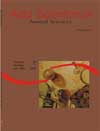<strong>Bone quality of broilers fed diets with phytase and reduced nonphytate phosphorus levels</strong> - DOI: 10.4025/actascianimsci.v30i3.496
Abstract
It was evaluated the mineral content, density, weight, morphometry and breaking strength of tibiae in broilers fed diets containing phytase and reduced nonphytate phosphorus levels (NPP). The experimental design was completely randomized and factorial arrangement 2 x 3 with two phytase levels (0 and 25U/kg) and three NPP levels (100, 85 and 70% of the requirements) in a total of six treatments and five replicates. There was no effect of NNP levels and/or phytase on phosphorus and ashes levels, weight, length and diameter. Interaction NPP x phytase was significant to Ca content that was lower in tibiae of birds fed diets with 70% of NPP and with no phytase. Proximal epiphysis density decresead due the reduction of NPP and increased with phytase inclution in the diet. There was effect of the interaction NPP x phytase to diaphysis, distal epiphysis and mean densities. Breaking force decreasead in birds fed diets with 70% of NPP. Diets with 85% of NPP requirements, supplemented with 25U/kg of phytase, can be used with no negative effects on mineral content, density, weight, morphometry and breaking strength of broilers tibiae. Key words: bone density, bone mineralization, breaking strengthDownloads
Download data is not yet available.
Published
2008-11-06
How to Cite
Oliveira, M. C. de, Marques, R. H., Gravena, R. A., Bruno, L. D. G., Rodrigues, E. A., & Moraes, V. M. B. de. (2008). <strong>Bone quality of broilers fed diets with phytase and reduced nonphytate phosphorus levels</strong> - DOI: 10.4025/actascianimsci.v30i3.496. Acta Scientiarum. Animal Sciences, 30(3), 263-268. https://doi.org/10.4025/actascianimsci.v30i3.496
Issue
Section
Nonruminant Nutrition
DECLARATION OF ORIGINALITY AND COPYRIGHTS
- I Declare that current article is original and has not been submitted for publication, in part or in whole, to any other national or international journal.
The copyrights belong exclusively to the authors. Published content is licensed under Creative Commons Attribution 4.0 (CC BY 4.0) guidelines, which allows sharing (copy and distribution of the material in any medium or format) and adaptation (remix, transform, and build upon the material) for any purpose, even commercially, under the terms of attribution.
Read this link for further information on how to use CC BY 4.0 properly.
0.9
2019CiteScore
29th percentile
Powered by 








































